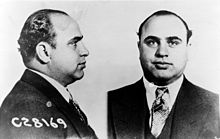Mug shot

A mug shot, or booking photograph, is a photographic portrait taken after one is arrested.[1] The purpose of the mug shot is to allow law enforcement to have a photographic record of the arrested individual to allow for identification by victims and investigators. Most mug shots are two-part, with one side-view photo, and one front-view.
History
The mug shot was invented by Allan Pinkerton, a famous U.S. detective of the 19th Century. The Pinkerton National Detective Agency first began using these on Wanted posters from the Wild West days. By the 1870s the agency had amassed the largest collection of mug shots in the United States.[2] The paired arrangement may have been inspired by the 1865 prison portraits taken by Alexander Gardner of accused conspirators in the Lincoln assassination trial, though Gardner's photographs were full-body portraits with only the heads turned for the profile shots.
Prior to the advent of computer technology, the accused was asked to hold a card with his name, the date, and other relevant information on it. In recent years, digital photography is used for the booking process, and the accused is no longer asked to hold the card while the photo is taken. Rather, the digital photograph is linked to a database record concerning the arrest.
Etymology
The term derives from mug, an English slang term for face, dating from the 18th century.[3]
The phrase is also sometimes used to refer to any small picture of a face used for any other reason.[citation needed]
Prejudicial nature
The U.S. legal system has long held that mug shots can have a negative effect on juries. The United States Court of Appeals for the District of Columbia Circuit held 'The double-shot picture, with front and profile shots alongside each other, is so familiar, from 'wanted' posters in the post office, motion pictures and television, that the inference that the person involved has a criminal record, or has at least been in trouble with the police, is natural, perhaps automatic.' [4] The Handbook of Massachusetts Evidence says "Because of the risk of prejudice to the defendant inherent in the admission of photographs of the 'mug shot' variety, judges and prosecutors are required to 'use reasonable means to avoid calling the jury's attention to the source of such photographs used to identify the defendant.'" (p.617) Elsewhere it cites a ruling in Commonwealth v. Martin "admission of a defendant's mug shot is 'laden for characterizing the defendant as a careerist in crime'" Other states have similar rules. [5]
Copyright status
Federal booking photographs are automatically entered into the public domain in the United States, and can be obtained by anyone through the Freedom of Information Act, except in special cases when the arrestees' record has been sealed.[citation needed]
See also
References
- ^ Michael H. Graham (2003). Handbook of Illinois Evidence. Aspen Publishers. p. 147. ISBN 978-0735544994.
- ^ Julie K. Petersen (2007). Understanding Surveillance Technologies: Spy Devices, Privacy, History, & Applications. Auerbach Publications. p. 26. ISBN 978-0849383199.
- ^ Online Etymology Dictionary
- ^ Barnes v. United States, 124 U.S.App.D.C. 318, 365 F.2d 509, 510--11 (1966)
- ^ "Where admitted, to the extent possible, the mug shots should be taped over or cut to delete all reference to booking information and be undated. The photographs should not be referred to as either "mug shots" or "booking photographs."" Handbook of Illinois Evidence, Michael H. Graham, §401.8 (citations omitted)
External links
- Celebrity Mug Shots - slideshow by Life magazine
